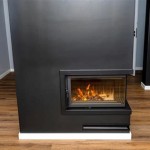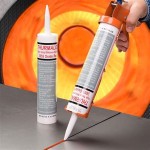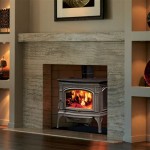Here is the article:
Stone Fireplace Mantels: A Timeless Focal Point
Stone fireplace mantels have served as architectural centerpieces for centuries, evolving from purely functional structures designed to support the fireplace opening to sophisticated design elements that enhance the aesthetic appeal of a room. They represent a fusion of practicality and artistry, offering a durable and visually striking feature that anchors the living space. The inherent beauty of natural stone, combined with skilled craftsmanship, results in a unique and enduring addition to any home.
The selection of a stone fireplace mantel involves consideration of several factors, including the architectural style of the home, the desired aesthetic, the available budget, and the structural requirements of the fireplace. Different stone types offer varying degrees of durability, porosity, and color variation, each contributing a distinct character to the finished mantel. Furthermore, the dimensions of the fireplace and the surrounding room must be carefully considered to ensure a balanced and harmonious design.
Types of Stone Used for Fireplace Mantels
The diverse range of natural stone available provides homeowners with a multitude of options when selecting a material for their fireplace mantel. Each stone type possesses unique characteristics that contribute to its overall appearance and suitability for the application. Some of the most commonly used stones include:
Marble: Renowned for its elegance and timeless appeal, marble is a metamorphic rock formed from recrystallized carbonate minerals, most commonly calcite or dolomite. Its distinctive veining patterns and smooth, polished surface create a luxurious aesthetic. Marble is relatively soft compared to other stones, making it easier to carve and shape into intricate designs. However, its porosity makes it susceptible to staining and etching, requiring regular sealing and maintenance. Carrara marble, with its subtle gray veining, and Calacatta marble, characterized by bolder gold and gray veins, are popular choices for fireplace mantels.
Granite: A durable and versatile igneous rock, granite is composed primarily of quartz, feldspar, and mica. Its strength and resistance to heat and scratching make it an ideal material for fireplace mantels. Granite is available in a wide range of colors and patterns, offering diverse aesthetic options. Its non-porous nature minimizes staining and water damage, simplifying maintenance. Black granite, with its sleek and modern appearance, and speckled granite, with its intricate mineral patterns, are frequently selected for contemporary fireplace designs.
Limestone: A sedimentary rock composed primarily of calcium carbonate, limestone offers a natural and understated elegance. Its soft, earthy tones and subtle texture create a warm and inviting atmosphere. Limestone is relatively porous and requires sealing to prevent staining and water damage. Its ease of carving allows for intricate detailing and customization. Indiana limestone, known for its consistent color and fine grain, is a popular choice for traditional fireplace mantels.
Slate: A fine-grained metamorphic rock derived from shale, slate is prized for its durability and distinct layered appearance. Its naturally cleft surface adds texture and visual interest. Slate is resistant to heat and staining, making it a practical choice for fireplace mantels. Its dark gray or black color provides a dramatic contrast against lighter walls. Slate mantels often feature a rustic or contemporary design.
Soapstone: A metamorphic rock composed primarily of talc, soapstone is known for its smooth, tactile surface and excellent heat retention properties. Its resistance to stains, acids, and alkalis makes it a particularly durable and low-maintenance option for fireplace mantels. Soapstone darkens over time with exposure to heat and oils, developing a unique patina. Its neutral gray color complements a variety of interior styles.
Design Considerations for Stone Fireplace Mantels
The design of a stone fireplace mantel should complement the architectural style of the home and reflect the homeowner's personal taste. Several design considerations should be taken into account to ensure a cohesive and aesthetically pleasing result:
Scale and Proportion: The size of the mantel should be proportional to the size of the fireplace and the surrounding room. A mantel that is too large can overwhelm the space, while a mantel that is too small may appear insignificant. The height of the mantel should also be considered in relation to the ceiling height and the overall proportions of the room. A general rule of thumb is that the mantel should be approximately two-thirds the width of the fireplace and positioned at a comfortable viewing height.
Style and Detailing: The style of the mantel should complement the architectural style of the home. Traditional homes often feature ornate mantels with intricate carvings and moldings, while contemporary homes may opt for simpler, more streamlined designs. The detailing of the mantel can also contribute to its overall aesthetic. Carved corbels, fluted pilasters, and decorative friezes can add visual interest and character to a traditional mantel. Clean lines, geometric shapes, and minimalist detailing are characteristic of contemporary mantels.
Hearth Integration: The hearth, the area in front of the fireplace opening, should be integrated seamlessly with the mantel. The hearth can be made of the same stone as the mantel or a contrasting material to create visual interest. The size of the hearth should be sufficient to protect the surrounding flooring from sparks and embers. The hearth can be flush with the floor or raised to create a more prominent feature.
Surround Materials: The materials used to surround the fireplace opening, such as brick, tile, or stone veneer, should complement the mantel and the overall style of the room. Coordinating the colors and textures of the surround materials with the mantel can create a cohesive and harmonious design. Contrasting materials can also be used to create visual interest and highlight the mantel as a focal point.
Installation and Maintenance of Stone Fireplace Mantels
The installation of a stone fireplace mantel requires specialized skills and knowledge due to the weight and fragility of the stone. It is essential to hire a qualified contractor with experience in stone masonry and fireplace installation.
Structural Support: The mantel must be properly supported to ensure its stability and longevity. Depending on the size and weight of the mantel, additional structural support may be required, such as steel brackets or reinforced concrete. The mantel should be securely anchored to the wall studs or masonry using appropriate fasteners. The contractor should ensure that the wall is strong enough to support the weight of the mantel.
Sealing and Protection: Most types of natural stone are porous and require sealing to protect them from staining and water damage. The mantel should be sealed with a high-quality stone sealant before installation and resealed periodically as needed. The frequency of resealing depends on the type of stone and the level of exposure to moisture and staining agents. The sealant should be applied according to the manufacturer's instructions.
Cleaning and Maintenance: Regular cleaning and maintenance are essential to preserve the beauty and longevity of a stone fireplace mantel. The mantel should be dusted regularly with a soft cloth to remove surface dirt and debris. Spills should be wiped up immediately to prevent staining. Avoid using harsh chemicals or abrasive cleaners, as these can damage the stone surface. For deeper cleaning, use a stone-specific cleaner or a mild soap and water solution. Rinse thoroughly with clean water and dry with a soft cloth.
Heat Exposure Considerations: While stone is generally heat resistant, prolonged exposure to high temperatures can cause discoloration or cracking. It is important to maintain a safe distance between the fireplace opening and the mantel. Consider installing a heat shield or using a non-combustible material behind the mantel to protect it from excessive heat.
Choosing a stone fireplace mantel is an investment in the aesthetic appeal and value of a home. By carefully considering the type of stone, design, and installation requirements, homeowners can create a stunning and enduring focal point that will be enjoyed for generations to come. Proper maintenance will ensure that the mantel retains its beauty and functionality for years to come.

Conrad Cast Stone Fireplace Mantel Old World Stoneworks

Cast Fireplace Mantels Integrate With Veneer Stone New England

The Diez Classic Stone Fireplace Mantel

Craig Cast Stone Fireplace Mantel Mantels Direct

The Diez Classic Stone Fireplace Mantel Surrounds

Essex Stone Fireplace Mantel

Rustic Floating Fireplace Mantel

Amhurst Cast Stone Fireplace Mantels Old World Stoneworks

Parisian Majestic Series Stone Fireplace Mantel Mantels Direct

Newport Cast Stone Fireplace Surround Oregon Castings And Design
Related Posts








